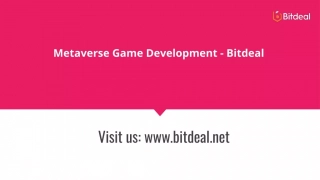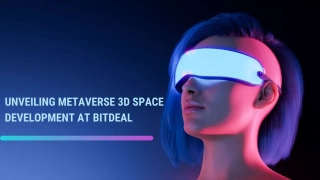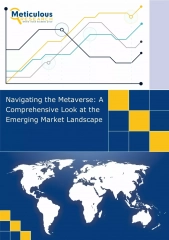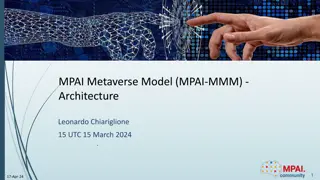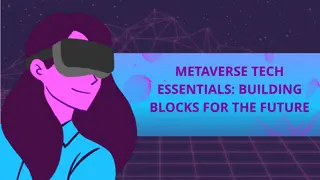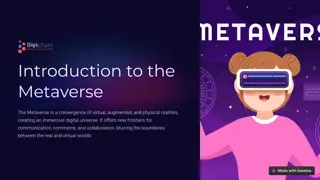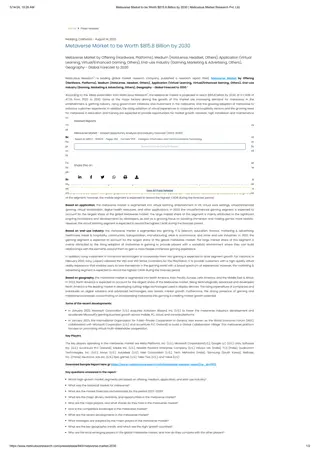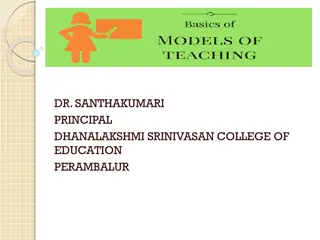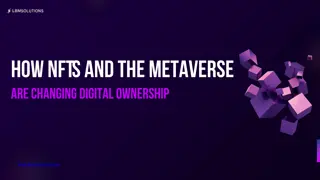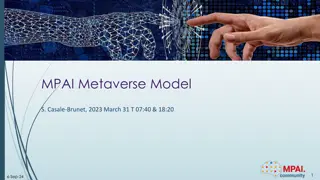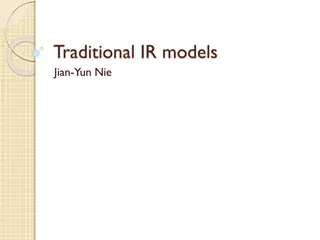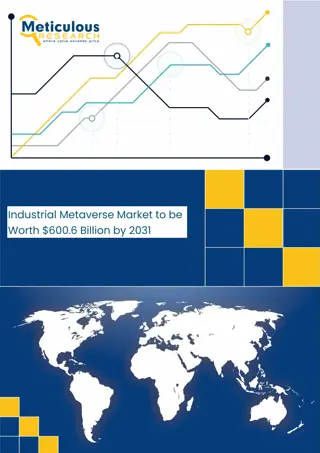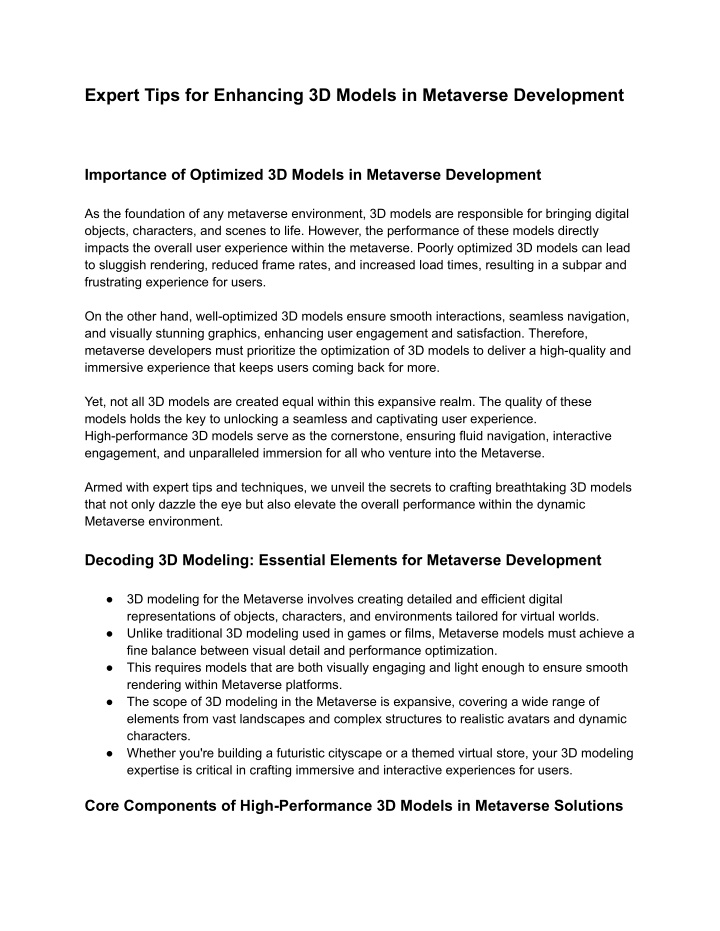
Expert Tips for Enhancing 3D Models in Metaverse Development
nIn the rapidly evolving realm of the Metaverse, a boundless virtual world filled with endless possibilities. At its core, the Metaverse thrives on the intricate artistry of 3D models, breathing vitality into every object, character, and landscape that populates its digital expanse. Without these models, the Metaverse would exist as a barren canvas, devoid of the immersive encounters that define its essence. Letu2019s explore how metaverse development is transforming digital platforms.
Download Presentation

Please find below an Image/Link to download the presentation.
The content on the website is provided AS IS for your information and personal use only. It may not be sold, licensed, or shared on other websites without obtaining consent from the author. If you encounter any issues during the download, it is possible that the publisher has removed the file from their server.
You are allowed to download the files provided on this website for personal or commercial use, subject to the condition that they are used lawfully. All files are the property of their respective owners.
The content on the website is provided AS IS for your information and personal use only. It may not be sold, licensed, or shared on other websites without obtaining consent from the author.
E N D
Presentation Transcript
Expert Tips for Enhancing 3D Models in Metaverse Development Importance of Optimized 3D Models in Metaverse Development As the foundation of any metaverse environment, 3D models are responsible for bringing digital objects, characters, and scenes to life. However, the performance of these models directly impacts the overall user experience within the metaverse. Poorly optimized 3D models can lead to sluggish rendering, reduced frame rates, and increased load times, resulting in a subpar and frustrating experience for users. On the other hand, well-optimized 3D models ensure smooth interactions, seamless navigation, and visually stunning graphics, enhancing user engagement and satisfaction. Therefore, metaverse developers must prioritize the optimization of 3D models to deliver a high-quality and immersive experience that keeps users coming back for more. Yet, not all 3D models are created equal within this expansive realm. The quality of these models holds the key to unlocking a seamless and captivating user experience. High-performance 3D models serve as the cornerstone, ensuring fluid navigation, interactive engagement, and unparalleled immersion for all who venture into the Metaverse. Armed with expert tips and techniques, we unveil the secrets to crafting breathtaking 3D models that not only dazzle the eye but also elevate the overall performance within the dynamic Metaverse environment. Decoding 3D Modeling: Essential Elements for Metaverse Development 3D modeling for the Metaverse involves creating detailed and efficient digital representations of objects, characters, and environments tailored for virtual worlds. Unlike traditional 3D modeling used in games or films, Metaverse models must achieve a fine balance between visual detail and performance optimization. This requires models that are both visually engaging and light enough to ensure smooth rendering within Metaverse platforms. The scope of 3D modeling in the Metaverse is expansive, covering a wide range of elements from vast landscapes and complex structures to realistic avatars and dynamic characters. Whether you're building a futuristic cityscape or a themed virtual store, your 3D modeling expertise is critical in crafting immersive and interactive experiences for users. Core Components of High-Performance 3D Models in Metaverse Solutions
Creating high-performance 3D models is essential for delivering smooth and immersive experiences in metaverse solutions. Several key components contribute to the performance and visual quality of 3D models, and understanding these factors is crucial for optimizing the models effectively. Polygon Count and Mesh Complexity The polygon count refers to the number of polygons or faces that make up a 3D model. Higher polygon counts result in more detailed and smoother surfaces but also increase the computational overhead. Metaverse developers must strike a balance between model complexity and performance by optimizing the polygon count based on the intended use case and target devices. Techniques like mesh decimation and retopology can help reduce polygon count while preserving visual fidelity. Texture Resolution and Optimization Textures are images that are mapped onto the surfaces of 3D models to add visual detail and realism. The resolution of these textures directly impacts the model's memory footprint and rendering performance. Metaverse developers should optimize texture resolution based on the model's distance from the viewer and the level of detail required. Techniques like texture compression, mipmapping, and atlas packing can help reduce memory usage and improve loading times. Material Properties and Shading Materials define how a 3D model interacts with light and renders in the metaverse environment. Properly configured material properties, such as diffuse, specular, and normal maps, contribute to the model's visual quality and realism. However, complex material setups can impact performance. Metaverse developers should optimize materials by using efficient shading models, reducing the number of texture samplers, and employing techniques like baked lighting and texture atlases. Lighting and Shadows Lighting and shadows play a crucial role in creating depth, atmosphere, and realism in metaverse environments. However, real-time lighting calculations can be computationally expensive. To optimize performance, metaverse developers can employ techniques like baked lighting, where static lighting information is precalculated and stored in textures. This approach reduces runtime calculations and improves rendering speed. Additionally, optimizing shadow maps and using efficient shadow algorithms can help minimize the performance impact of dynamic shadows. Level of Detail (LOD) and Mesh Simplification
Level of Detail (LOD) is a technique used to create multiple versions of a 3D model with varying levels of complexity. LOD models are dynamically switched based on the model's distance from the viewer, ensuring that highly detailed models are used when close to the camera, while simplified versions are rendered for distant objects. This approach optimizes performance by reducing the polygon count and texture resolution of models that are farther away. Mesh simplification algorithms can automate the process of generating LOD models. Insights for Efficient 3D Models in Metaverse Creation Tip 1: Optimize with a Solid Concept and Plan Pre-Production Planning: Effective 3D modeling starts with thorough pre-production planning. Before diving into the creation process, clearly outline the model's purpose and intended use within the Metaverse. Open communication with clients to understand their vision is essential at this stage. Sketching and Concept Art: Visualize your ideas through sketches and concept art. This step helps you identify potential areas for optimization early on, saving time and resources during the modeling phase. Purpose of Model and Function: Understanding the specific role your 3D model will play in the Metaverse is crucial. Whether it's a static background object, an interactive character, or a wearable item, knowing the purpose will help tailor the level of detail and functionality for optimal performance. Tip 2: Use Efficient Geometry for Performance Balancing Detail and Efficiency: Achieving high performance in 3D models requires balancing visual detail with efficient geometry. While intricate details enhance realism, they can increase the polygon count and impact rendering speed. Techniques for Reducing Polygon Count: Utilize methods such as Level of Detail (LOD) to create multiple versions of a model with varying polygon counts. This approach allows for high-detail models in close-up views and simplified versions for distant objects, optimizing processing power. Using Efficient Topology: Well-organized topology is key to efficient rendering and animation. A clean and efficient topology ensures a smoother user experience within the Metaverse. Tip 3: Implement High-Quality Textures and Materials Importance of Texturing:
Textures bring 3D models to life by adding color, detail, and surface features. However, unoptimized textures can hinder performance. Striking a balance between visual quality and file size is essential. Effective UV Mapping: UV mapping unwraps the 3D model s surface onto a 2D plane, allowing for proper texture application. Efficient UV mapping minimizes wasted space and improves rendering efficiency. Optimizing Texture Resolution: Strategies such as using texture atlases to combine multiple textures into a single file can reduce the number of individual textures that need to be loaded, enhancing performance. Efficient use of normal and bump maps adds detail without increasing the polygon count. Tip 4: Bake Advanced Lighting and Shadows Enhancing Visual Appeal with Lighting: Lighting is crucial for creating immersive experiences in the Metaverse. Strategic lighting techniques can enhance realism and atmosphere while maintaining performance. Techniques for Realistic Lighting: Bake light maps to pre-calculate lighting effects on the model s textures, reducing real-time processing requirements. Combine dynamic and static lighting to balance realism and efficiency. Global Illumination and Ambient Occlusion: These techniques simulate realistic lighting effects like natural light bouncing off surfaces and subtle shadows, enhancing the believability of the environment while considering performance constraints. Tip 5: Utilize Smooth and Realistic Animations Importance of Animation: Animations make 3D models interactive and engaging. Smooth animations are essential for a seamless user experience in the Metaverse. Keyframe Animation vs. Motion Capture: Keyframe animation involves manually creating key poses, while motion capture records real-world movements for realistic animation. Both methods have their place in Metaverse development. Optimizing Animation Performance: Simplify rigging by removing unnecessary bones and maintaining a clean hierarchy. Reducing the bone count in rigs improves performance, especially for environments with many animated characters.
Tip 6: Use Effective Tools and Software Recommended Software for 3D Modeling: Blender: A free, open-source software offering comprehensive features for modeling, animation, texturing, and rendering. Autodesk Maya: An industry-standard tool for professional 3D modeling, animation, and rendering. 3ds Max: Known for its extensive toolset, it s ideal for professional game and animation pipelines. Utilizing Plugins and Extensions: Streamline your workflow by utilizing plugins designed to meet specific needs such as polygon reduction, texture baking, and animation optimization. Staying Updated with the Latest Tools and Trends: Stay informed about the latest software versions, industry trends, and optimization techniques to keep your skills and tools cutting-edge. Tip 7: Conduct Performance Profiling and Optimization Iterations Ensuring Compatibility Across Devices: Test your 3D models on various hardware and software configurations to ensure compatibility and smooth performance across all platforms. Techniques for Performance Testing: Conduct stress testing to identify potential bottlenecks. Collect user feedback to improve models iteratively. Tools for Profiling and Optimization: Use profiling tools to analyze performance within the Metaverse platform, identifying areas for optimization to enhance user experience. Osiz Expertise in 3D Modeling and Metaverse Development By integrating these expert tips and continuously refining your techniques, you'll be equipped to create high-performance 3D models that elevate the visual impact and ensure a seamless user experience within the Metaverse. As the digital landscape evolves, your proficiency in crafting optimized 3D models will place you at the cutting edge of developing immersive virtual environments.
At Osiz, a leading metaverse development company, we understand the significance of high-performance 3D models for creating compelling Metaverse experiences. Our expert 3D modelers and seasoned developers are adept at guiding you through the entire development process. From initial concept and optimization to seamless integration across various Metaverse platforms, we ensure your vision comes to life with exceptional performance. Don't let performance limitations hold back your Metaverse projects. Source: https://www.osiztechnologies.com/blog/metaverse-development-insider-tips-crafting-3d-models



